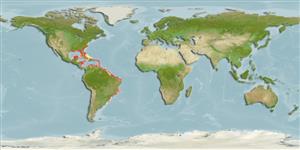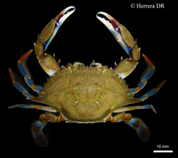Callinectes ornatus Ordway, 1863
Shelling crab| Native range | All suitable habitat | Point map | Year 2050 |

|
| This map was computer-generated and has not yet been reviewed. |
| Callinectes ornatus AquaMaps Data sources: GBIF OBIS |
Classification / Names Common names | Synonyms | CoL | ITIS | WoRMS
Malacostraca | Decapoda | Portunidae
Environment: milieu / climate zone / depth range / distribution range Ecology
Benthopelagic; depth range 0 - 75 m (Ref. 367). Tropical; 18°C - 31°C (Ref. 367); 38°N - 34°S, 94°W - 32°W
Distribution Countries | FAO areas | Ecosystems | Occurrences | Introductions
Western Atlantic: USA to Brazil. Tropical to subtropical.
Length at first maturity / Size / Weight / Age
Maturity: Lm 3.8 range ? - ? cm Max length : 13.0 cm CW male/unsexed; (Ref. 367); 11 cm CW (female); max. reported age: 2.40 years (Ref. 85497)
Short description Morphology
Life cycle and mating behavior Maturity | Reproduction | Spawning | Eggs | Fecundity | Larvae
Main reference
References | Coordinator | Collaborators
Melo, G.A.M. 1996 Manual de identifição dos Brachyura (Caranguejos e Siris) do littoral brasileiro. Editora Plêiade FAPSES 604 p. (Ref. 8729)
IUCN Red List Status
(Ref. 130435: Version 2025-1)
CITES status (Ref. 108899)
CMS (Ref. 116361)
Threat to humans
Human uses
Fisheries: commercial
| FishSource |
Tools
More information
Max. ages / sizes
Length-weight rel.
Length-length rel.
Length-frequencies
Mass conversion
Abundance
Internet sources
BHL | BOLD Systems | CISTI | DiscoverLife | FAO(Publication : search) | Fishipedia | GenBank (genome, nucleotide) | GloBI | Gomexsi | Google Books | Google Scholar | Google | PubMed | Tree of Life | Wikipedia (Go, Search) | Zoological Record



